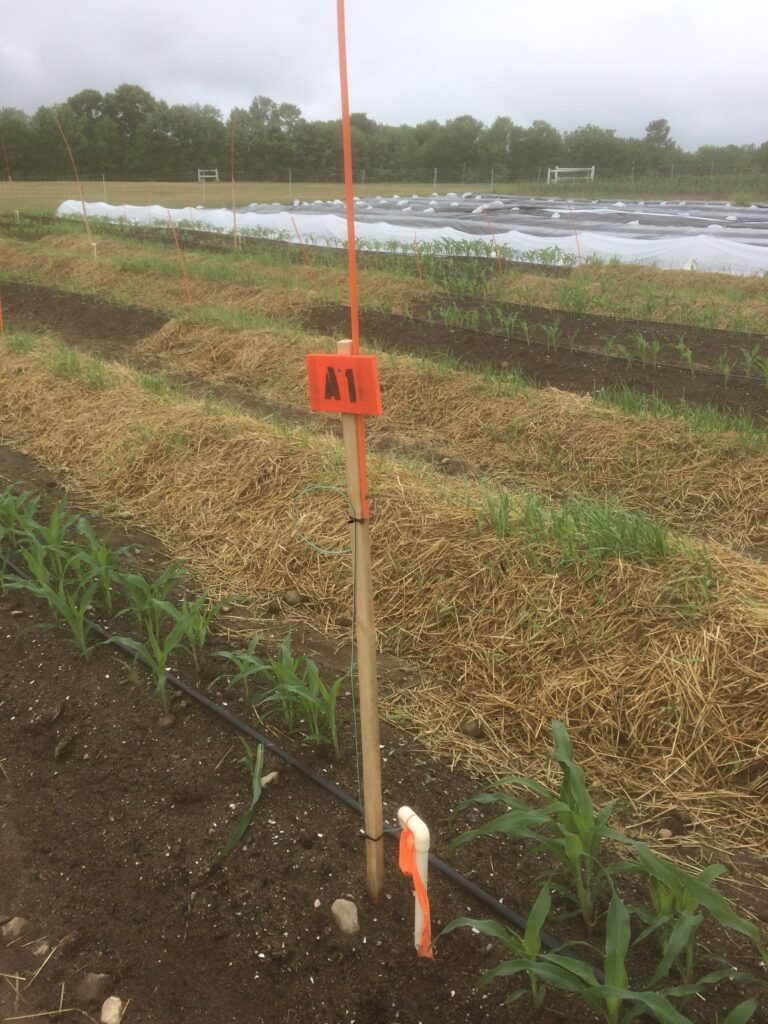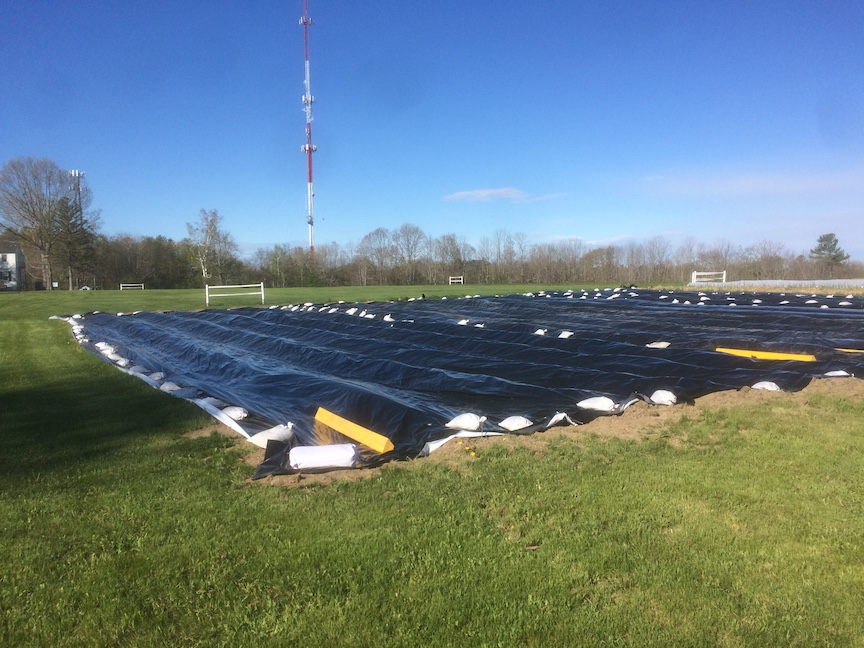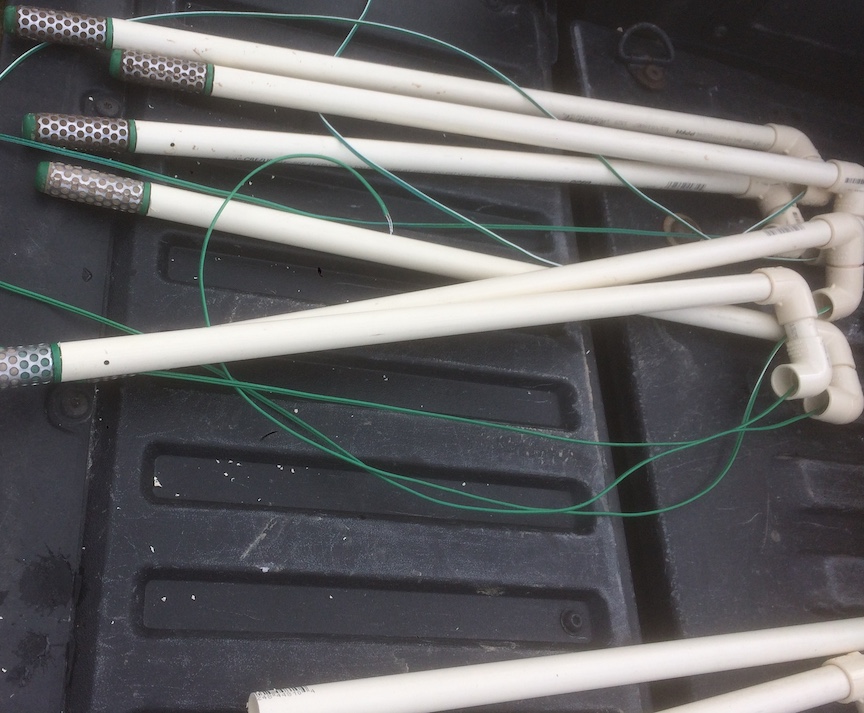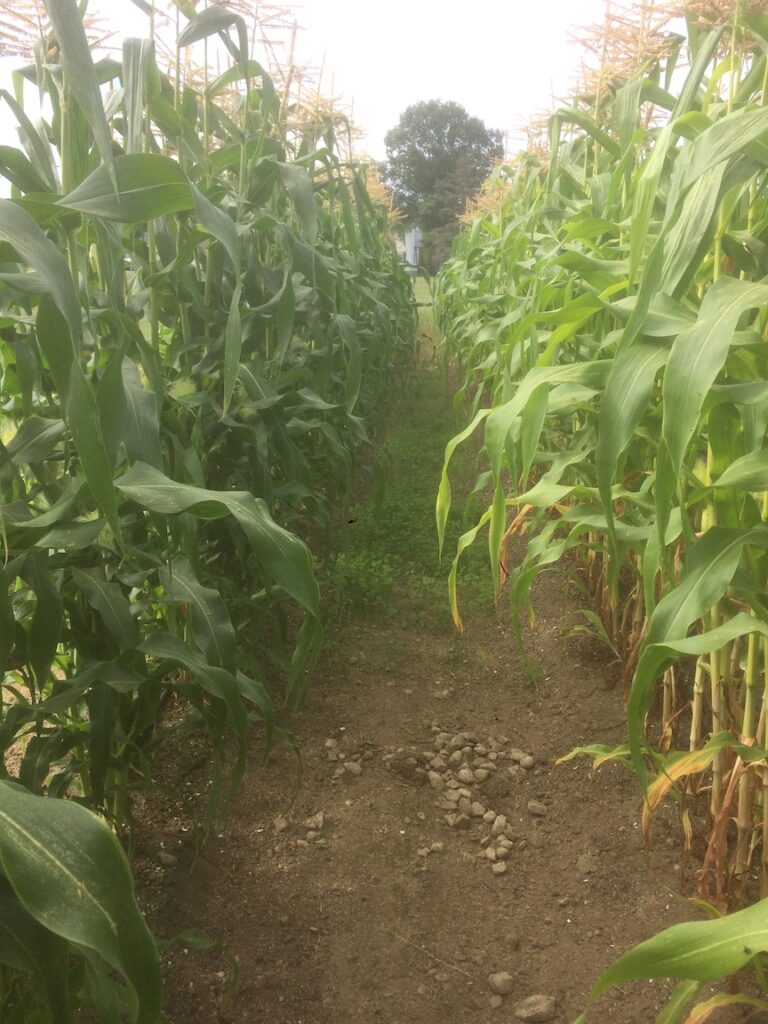By Holli Cederholm
In the past several years, farmers in Maine have struggled to cope with drought, severe precipitation events, excessive wind, temperature extremes and hail storms. Across the world, farmers are on the frontlines of volatile weather caused by climate change. From vegetable and small fruit producers to dairy farmers and forest managers, climate change threatens seasonal crop loss, financial risk and worse.
A new one-year pilot program, which is wrapping up in January 2022, seeks to empower vegetable farmers and small fruit producers in the Northeast, and the agricultural service providers that work with them, to lead the way in identifying creative, field-based solutions to become more resilient in the face of climate unpredictability.
The Climate Adaptation Fellowship, coordinated through the University of Maine, in partnership with Rutgers and the USDA Northeast Climate Hub, and funded by the Northeast Sustainable Agriculture Research and Education program (NE-SARE), integrates climate science and land-based knowledge through a peer-to-peer learning model in which approximately 20 pairs of farmers and agricultural service providers collaborated on envisioning and enacting climate adaptation practices in real time on real farms.

Farm and greenhouse manager Ben Crockett and Jason Lilley of the University of Maine Cooperative Extension, one of the CAF pairs, assessed available soil moisture in sweet corn plantings throughout the 2021 growing season to inform irrigation practices of long-term vegetable crops already in rotation on the farm. Soil moisture was monitored using moisture sensors across three treatments (straw, interseeded cover crop and bare ground) applied to corn. Photo courtesy of Ben Crockett
Rachel Schattman, the program’s coordinator and an assistant professor of sustainable agriculture at the University of Maine, has worked as both a commercial farmer and an agricultural service provider and sees synergistic and practical reasons for partnering the two. “Climate change is a time-sensitive issue. We really don’t have time to mess around,” says Schattman.
“Farmers have this deep, endemic knowledge of their land and what it is like to be a grower.” She adds that they are also intimate with the constraints of agriculture. “Running a farm is a very complicated endeavor and nobody knows it better than they do.”
Agricultural service providers, which Schattman defines as anyone who provides direct assistance to growers, whether it’s through Cooperative Extension, a federal or state agency, a conservation district or a private entity, bring other things to the table, including specific training and dedicated time to devote to investigating and answering questions in different ways.
Both groups, says Schattman, are eager to address climate change on the ground. They’re “ready to get down into the weeds about what it means on the farm to adapt — what the capacity is to use farm-scale production to contribute to mitigation.”
The fellowship allows them to do just that. With collaborators spread across nine northeastern states — with Maine being the most widely represented — the program began with climate-specific workshops on principles of energy efficiency, carbon sequestration, water usage and soil health.
From there, each pair conducted a climate risk assessment of the grower’s farm, including gauging risks particular to their operation and location, and what they could do to minimize these threats. While producers were not required to change anything on their farm as part of the program, many opted to do so.
Among other things, the producers expressed worry about inconsistent precipitation and extreme temperatures. “There was a lot of concern about heat … the number of really, really hot days in the summer and having that be bad for both the plants and … the workers,” says Schattman. A fellowship project in Connecticut trialed possible ways to lower the temperature of pumpkin flowers, as pollen viability declines in relation to temperature, to lessen crop loss resulting from heat waves.
There was also concern around dealing with drought, in terms of soil management to retain moisture during critical periods and water management to ensure irrigation was feasible when it was needed most — without investing a lot of money into deeper or additional wells or pumping systems to draw off surface water. Soil moisture was a focus for multiple pairs within the pilot’s cohort.
A flower farmer and service provider in Massachusetts assessed soil moisture loss in walkways treated with various mulches in relation to water availability in the production area of calendula. Another project in Maine, detailed below, compared moisture readings between sweet corn grown with treatments of straw mulch, interseeded cover crops and bare ground cultivation.
Most striking of all, says Schattman, was that many participants felt that climate mitigation was important for the long term. “A lot of folks took a really big picture view and expressed a lot of concern about the well-being of future generations and our ability to produce food into the future, and not wanting to be part of a system that made things worse.”
Monitoring Soil Moisture: A Case Study in Corn
At Morrison Center’s Opportunity Farm in New Gloucester, Maine, farm and greenhouse manager Ben Crockett and Jason Lilley of the University of Maine Cooperative Extension assessed available soil moisture in sweet corn plantings throughout the 2021 growing season to inform irrigation practices of long-term vegetable crops already in rotation on the farm. Crockett and Lilley applied three treatments — straw mulch, an interseeded cover crop and open cultivation — to four varieties of bicolor synergistic sweet corn from Johnny’s Selected Seeds (Allure, Montauk, Sweetness and Temptress) that met the needs of Crockett’s existing crop plan.

The subject plots were planted in a hilltop field with Paxton fine sandy loam soil, good drainage and exposure to prevailing wind conditions. The ground was tarped for four weeks before eight 100-foot beds (4 feet apart on center) were formed with a borrowed tractor. Crockett seeded each bed with two rows of corn, with 16 to 18 inches between rows, and two beds were planted of each variety. Each treatment (straw, interseeded cover crop and bare ground) spanned one-third of each bed (33 feet); the lay-out was such that both sides of each bed were bordered by the same treatment (i.e., 2 feet of straw mulch, cover crop or clean cultivated area).
A single line of Netafim drip tape with 12-inch emitter spacing was set up within the beds, passing through all three treatments. Irrigation was applied evenly to each treatment.

At crop emergence, Crockett spread square bales of straw by hand at an approximate depth of 2 to 3 inches over and between the beds for sufficient ground coverage. For the cover crop treatment, a mix of crimson clover and annual ryegrass was broadcast by hand, at a seeding rate of 30 pounds per acre, in the between-row zone when the corn reached “V5” crop growth. (That is when the growing point of the corn plant is above the soil line and the fifth leaf “collar” — where the leaf sheath and leaf blade join — is visible). The remainder of the subject plots were left as bare soil, which Crockett cultivated every 10 days or so using a combination of hand tools — namely a stirrup hoe and wire hoe — to keep weed pressure down without disturbing the drip irrigation set-up.
They monitored soil moisture across the varieties and treatments throughout the season using 12 moisture sensors set at a depth of 12 inches, where the corn plant’s roots are. To better understand soil moisture changes throughout the soil profile, they also set four probes at a depth of 4 inches in one variety. The sensor placement followed randomized replicated design protocols to mitigate the impact of natural variance (i.e., greater exposure to westerly wind) across the test plots. The Irrometer Watermark soil sensors (roughly $40 each) connected to a single digital reader (about $250).
They hoped to use the quantifiable moisture data collected over the season to reduce irrigation overall while also fine-tuning the watering strategy to avoid irrigation at times it would not benefit the crop (i.e., when it was too early or when the irrigation would exceed water needs). Data collected by Schattman informed the project design — it showed that when farmers rely on a moisture field test or an irrigation schedule, they tend to overwater or underwater.
Observational data regarding corn maturation windows, harvest yields, the appearance of corn stalks and size of ears across the treatment were also collected. Additionally, Lilley was interested in assessing interplanting cover crops with a long-season crop that would remain in the ground into September. Late-season crops like sweet corn reduce the window of opportunity for farmers to plant a cover crop post-harvest — meaning these fields are often left bare and exposed over the winter months. Among other benefits, successfully interseeding and establishing living cover crops early could protect the soil from run-off and sequester carbon.
Q&A with Climate Adaptation Fellows
Q: Why did you choose to study soil moisture for your Climate Adaptation Fellowship?
Ben Crockett: There are multiple practices and strategies that were identified at the beginning of the CAF project for Opportunity Farm that would improve our adaptability to climate change, but in the end the focus on soil moisture was easy to implement and monitor over the period of the CAF program. The sandy loam soils and hilltop placement of the farm create frequent droughty conditions.
Jason Lilley: Ben and I did a deep dive into the various climate concerns on the farm. We discussed perennial plantings as windbreaks due to the farms’ hillside location, methods for increasing organic matter due to the sandy loam soils, and reduced tillage approaches to minimize soil erosion. Ultimately we identified soil moisture management as a primary problem due to the windy location and drought-prone soil type.
Q: Was there a measurable difference in soil moisture across the three treatments in your study? How did having real-time, site-specific moisture data influence your irrigation practices in the corn plantings this season?
Ben: On average, moisture levels were highest under the straw mulch. Moisture levels also had much less variability under mulch. Depending on the crop this may be desirable, but during wet periods moisture could be held in excess. Open cultivated/bare plots needed the most additional irrigation and had the widest swing between dry and wet soils. The intercropping seemed to be a good “happy medium,” shading the ground and reducing moisture loss at the surface, and absorbing extra moisture for their own growth, balancing between heavy rains and dry/hot stretches. The timing of intercrop seeding and species mix would most likely have varying effects.
Jason: It was very interesting to see the differences between our perceived estimates of soil moisture need, and actual need based on the soil moisture needs. The probes were set at 12 inches, which is where the majority of the crop roots are. The moisture levels at that depth proved to be very different from what we were experiencing at the soil surface. As a result, Ben decided to cut back on irrigation duration.
Ben: Plus, it helped me reduce irrigation in other crops as I got a “feel” for how quickly or slowly soil moisture was changing.
Q: Ben,is there any observational data that you would like to share?
Ben: Somewhat related to treatments, our lowest yields for plots were in the straw-mulched sections. There could be multiple reasons for this, but one obvious reason is high vole pressure, and the stands of corn in straw mulch sections getting eaten and mowed down by voles during early growth. Probably would have worked better if mulch was applied later during the growth period, like when we applied interseeding treatments (around V5 growth stage). Beyond that, the greatest difference was probably on maturation of corn, with interseeded treatment areas being a little slower and longer than the open cultivated control areas. My guess is that moisture stress response in the corn encouraged earlier ripening and maturation in open cultivated areas.
Q: Jason, past research points to benefits of intercropping cover crops to achieve multiple benefits, including soil stability and resilience during periods of heavy rainfall. What did you observe with the interplanting of clover, rye and sweet corn this season?
Jason: The site at Opportunity Farm was one of four interseeding trials that we ran this season. Three of those plots were in sweet corn, and one in fall brassicas. The sweet corn plots were all seeded at last cultivation. I was pleasantly surprised by the big reduction in weed growth and density in the interseeded plots compared to the bare soil plots. At one farm we experienced rill erosion down each of the bare soil rows from heavy September rains. The neighboring interseeded rows were fully protected. We did observe that the crimson clover really outcompeted the annual ryegrass, so there is still more research to be done on species selection, seeding-mix ratios, as well as timing and placement of the seed. In these trials, we waited until the V5 stage in the corn, or 30 days after transplanting brassicas, to avoid water and nutrient competition, and creating habitat for rodents.
Q: Ben, how will you apply your findings at Morrison Center in the future? What farm planning decisions can you make based on what you learned?

Ben: In the sweet corn (and most likely my other crops) I was overwatering and running irrigation longer than necessary. The farm’s water resources are old and reliability is waning, so using them efficiently and when most needed is a priority for a successful growing season. Exploring soil treatments’ effects on soil moisture has also encouraged me to update our SOPs for core 2021 crops; for example, I’m planning to interseed all of our sweet corn, and use a straw mulch in our cucurbits where crop moisture needs to be stable during fruit development. Both of these would be combined with 2 to 3 early season cultivations to reduce weeds and allow soil to warm up in the spring.
Q: Do you plan to apply any of these treatments to corn grown at Opportunity Farm next season? If so, which one(s) and why?
Crockett: As mentioned above, I definitely want to do some sort of interseeding in the sweet corn next year. This may grow into using similar methods on the farm with other late-season crops like fall squash or peppers. I think more importantly, and necessary to understand the effects of any treatment, is to do at least some soil moisture monitoring every year. Without data to back up theories, you can spend time and money on solutions that don’t really work for your farm. I’m planning to incorporate soil moisture readings into our day-to-day operations, just like we would measure and record rainfall or daily temperatures. Only thing I would change from this year is figuring out how to automate soil moisture recordkeeping, reducing labor time for data collection, and increase quality and frequency of data.
Q: Jason, what teachable takeaways are there for other farms in Maine? As an agricultural service provider, how does this impact your work in supporting farmers?
Jason: I was pumped to hear that Ben found the soil moisture data useful and really leaned into relying on that data to inform his decisions. Sometimes when us ag service providers identify tools and resources we think will be helpful for growers there can be logistical hurdles to feasibility and adoption on farms. The fact that Ben is planning to continue using this practice and saw benefits from their use is encouraging and I definitely plan to lean on him as a spokesman!
I was also encouraged about the interseeding results. I plan to continue doing research in this area, but feel comfortable encouraging and working with farms to implement this practice within the parameters of past identified hurdles. Seeing how well it worked to spread the seed immediately prior to last cultivation to get the seed into the soil was great data to have. That incorporates the past research data with the logistical and labor constraints of this practice being adopted on more working farms.
The Climate Adaptation Fellowship was made possible by SARE (subaward number ENE20-164-3426) and a final report will be available to the public.
